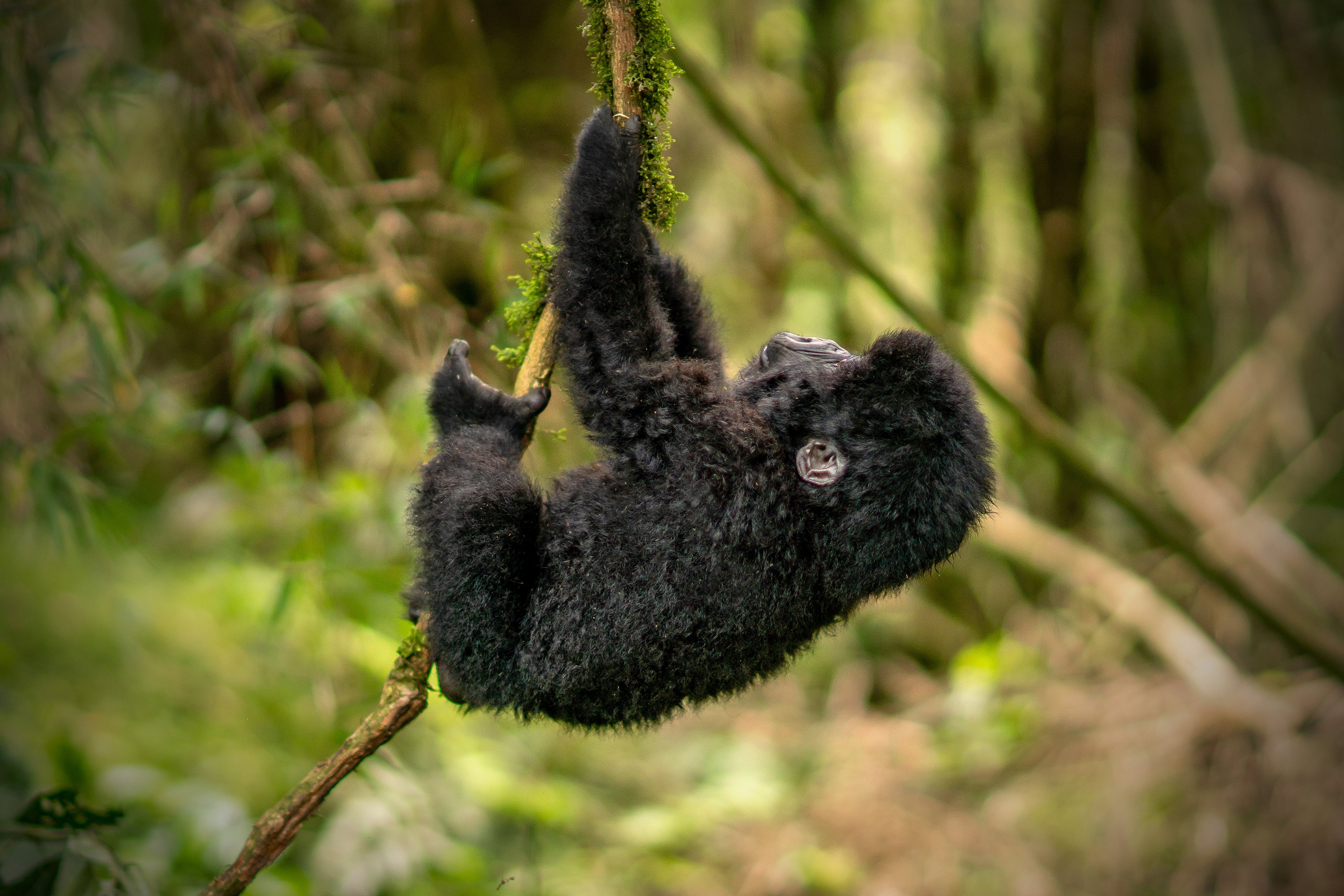
In 2011 Marcus Perlman saw a YouTube video of a gorilla named Zola spinning in circles while playing in a water puddle at the Calgary Zoo in Alberta. In 2017 he noticed Zola again, this time in a viral video from the Dallas Zoo in Texas. Zola whirled in a plastic blue kiddie pool as the water splashed up around him.
Perlman, a lecturer in English language and linguistics at the University of Birmingham in England, had done research on communicative gesturing, and the YouTube video sparked his curiosity about this form of great ape behavior display. He looked for more YouTube videos of spinning apes, and around 400 turned up. “They spin pirouettes on their feet; they do backflips; they roll on their side; they do somersaults forward; they roll down hills, spin on ropes,” Perlman says.
Perlman wasn’t alone in his fixation. Adriano Lameira, a primatologist and evolutionary psychologist at the nearby University of Warwick in England, shared Perlman’s fascination and watched videos of apes spinning online, too. Together they coauthored a recent paper in Primates that focuses on primate spinning—specifically, on rope twirls. In the videos they analyzed, orangutans, gorillas, chimpanzees and bonobos hung on with their hands to ropes or vines and turned through the air at dizzying speeds.
At first blush, such spinning might look like a stereotypy, a repeated movement that some animals make when bored. But to Lameira, the playfulness of the spinning in the videos seemed somehow different. It wasn’t just a way to pass the hours but rather an enriching and creative activity for the apes. The animals seemed to lose themselves in their movements. They would let go of the rope and topple over from unsteadiness—and then get up and spin again and again.
Cat Hobaiter, a primatologist at the University of St. Andrews in Scotland, who wasn’t involved in the study, says she has come across plenty of spinning in her work with wild chimpanzees and gorillas. “It’s one of their favorite kinds of play when they’re young,” she says, noting that in the wild, she’s seen it more often in gorillas, compared with other primates. “They’ll literally spin themselves until they kind of drop and fall over from dizziness, which is not something that I’ve really seen very much of in wild chimpanzees,” Hobaiter adds.
In their paper, Lameira and Perlman document the spinning and its speed and speculate about what it means that our closest animal relatives seem to like to spin in a way that humans sometimes do. Many great apes in captivity are being retired from medical research, making the hundreds of videos in existence an invaluable resource. “YouTube provided a volume of data that we would not have ever been able to collect,” Lameira says.
Spinning turns the world into a moving blur for apes—including humans. The feelings it generates disrupt the vestibular system, which senses changes in motion, orientation, position and the speed of the body. We might feel dizzy and light-headed, get a head rush and also feel elated or giggly. Perhaps for this reason, spinning is a staple of children’s play. Human children indulge in spinner bowls at playgrounds and in merry-go-rounds, carousels and carnival rides that spin them through the air. For autistic people, spinning serves as self-stimulation. In some orders of Sufism, a branch of Islam, whirling dervishes spin in circles as a form of religious dance in which the movement induces a spiritual and trancelike state. “Spinning is proactively tapped for rapture,” Lameira and Perlman write in their study.
The researchers compared the apes’ rope spinning speeds to human pirouettes in professional ballet and the turning of Ukrainian hopak dancers, Sufi whirling dervishes and suspended spinning-rope acts by circus artists. The apes spun with an average rotational velocity of 1.43 revolutions per second, and the fastest speed they reached was 3.3 turns per second. These are speeds that can induce physiological “highs” in humans.
Humans seek out altered mental states to lose themselves, says Marc Wittmann, a psychologist at the Institute for Frontier Areas of Psychology and Mental Health in Germany and author of the book Altered States of Consciousness: Experiences Out of Time and Self. “In altered states, we are present-oriented as we lose the sense of self and time,” he says. “When we are present-oriented, without past and future rumination, we feel much better.”
But Perlman says there’s a big jump from the feeling of humans spinning to projecting that gorillas experience an altered state of consciousness, even if we share physiology with primates that suggests they might experience similar physical effects.
“I’m sure that these gorillas are experiencing some sort of disruption to their perception because I’ve seen wild mountain gorillas who are doing this intense spinning,” Hobaiter says. “They drop to the ground; they fall over just as we do,” he says. “I’m sure that the world keeps spinning around them, even though you’re back on solid ground.”
Beyond that basic interpretation, what is happening in a gorilla’s head becomes tricky to interpret. “The big leap is whether or not that is pleasurable,” she says, “whether that’s something they seek out, whether they understand the connection between the two.”
And if a gorilla’s consciousness does shift, what would that be like to the ape? “Even if spinning leads to altered mental states in humans, that doesn’t mean that apes will experience the same kind of altered mental states,” says Annika Paukner, an associate professor in comparative psychology at Nottingham Trent University in England. The question of what is it like to spin should be explored in dogs, horses and birds before scientists reach any conclusions, she says. Follow-up research could look at the question of whether spinning is more common in gorillas, compared with other apes, and probe for other details such as preferences for twirling by sex or age.
The origins of spinning and how it developed is another question that intrigues researchers. “I can imagine this being sort of elaborated over millennia and over the course of human evolution,” Perlman says. “That basic drive to seek altered perception and altered mental states could be common to our primate cousins.” Many primate species do eat fermented foods, and it’s possible they get a bit soused, researchers have documented.
Spinning and consuming fermented fruit both relate to larger questions about how animals amuse themselves and what their pastimes might say about the experience of being a gorilla or chimp. In a 2015 Current Biology paper entitled “The What as well as the Why of Animal Fun,”Richard Byrne, a professor of evolutionary psychology at the University of St. Andrews, wrote that in the past, “suggesting that animals might enjoy themselves was seen as anathema to science.” Chimpanzees are seen playing with objects. But when we pay more attention to what they’re actually doing when immersed in play, more about their cognition could be revealed, Byrne wrote. Similarly, Lameira hopes that studying spinning might be one way to investigate if ancestors in the primate evolutionary line were regulating their mood by deviating from their normal awake states just for the thrill of it.
Seeing apes spin raises the possibility that nonhuman primates might indulge in the delight of manipulating their normal perceptual experiences in a similar way as humans who change consciousness through drugs, alcohol or physical activity. “It highlights the subjectivity of experience,” Perlman says, “and it opens up that maybe there are different perspectives on reality—not that they are necessarily thinking deeply about this difference.”


